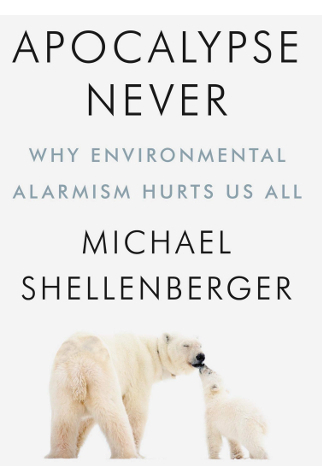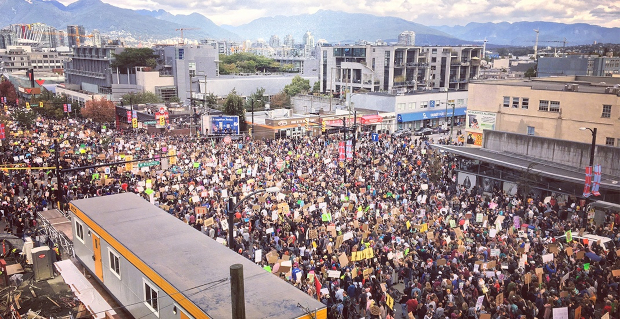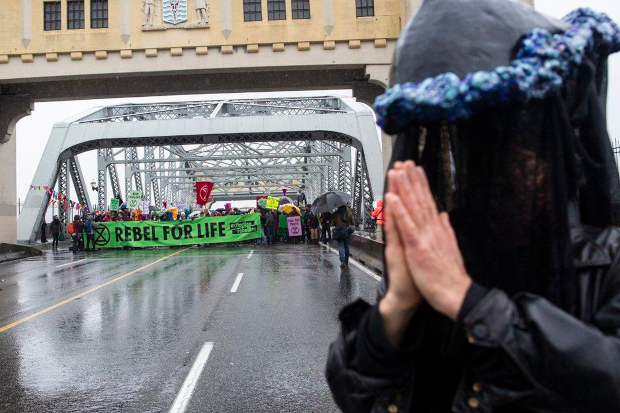
Reflections on Vancouver, British Columbia and other topics, related or not
Not so nigh after all
Michael Shellenberger’s Apocalypse Never
separates climate science from climactic incitement
Greg Klein | July 8, 2020
Crowds estimated at 100,000 in Vancouver and half a million in Montreal
attended Greta Thunberg’s 2019 Canadian visitation, part of a movement
that often suggests religious fervour.
Is this a mea culpa, a manifesto or a counter-revelation? “On Behalf Of Environmentalists, I Apologize For The Climate Scare.” Regardless, it’s a dramatic way to promote a book. Neither a climate change denier nor skeptic, Michael Shellenberger argues that the science has been misrepresented, manipulated even, for reasons ranging from personal gain to spiritual craving, and with extremely injurious results. That’s the message behind Apocalypse Never: Why Environmental Alarmism Hurts Us All.
He’s been a climate activist for 20 years, an environmental activist for 30 years and a political activist even longer. “At 17, I lived in Nicaragua to show solidarity with the Sandinista socialist revolution. At 23 I raised money for Guatemalan women’s cooperatives. In my early 20s I lived in the semi-Amazon doing research with small farmers fighting land invasions. At 26 I helped expose poor conditions at Nike factories in Asia.”
And at 49 he seems to have destroyed the basis for an end times belief that’s terrified schoolchildren, rationalized destructive protests and prevented beneficial endeavours. If he’s right, the bullshit has been enormous, absolutely enormous.

Much of it originates in distortions of findings by the United Nations’ Intergovernmental Panel on Climate Change, which supposedly timed the planet’s demise for 2030. But what the IPCC did state, as Shellenberger paraphrases it, was “to have a good chance of limiting warming to 1.5 degrees Celsius from preindustrial times, carbon emissions needed to decline 45 percent by 2030. The IPCC did not say the world would end, nor that civilization would collapse, if temperatures rose above 1.5 degrees Celsius.”
What about 2050, then? Did the IPCC call for a 70% reduction in emissions by that year? Yes, but that figure applied only to agricultural emissions, “which comprise a fraction of total greenhouse emissions.”
“Anyone who believes climate change could kill billions of people and cause civilizations to collapse might be surprised to discover that none of the IPCC reports contain a single apocalyptic scenario.”
Yet much responsibility for all that confusion lies with the UN group. “While the IPCC’s science is broadly sound, its Summary for Policymakers, press releases, and authors’ statements betray ideological motivations, a tendency toward exaggeration, and an absence of important context,” Shellenberger writes. “As we saw, IPCC authors and press statements have claimed sea level rise will be ‘unmanageable,’ world food supplies are in jeopardy, vegetarianism would significantly reduce emissions, poor nations can grow rich with renewables, and nuclear energy is relatively dangerous.”
Shellenberger refutes all of the above. But he spends a good part of the book building the case for nuclear energy, “the safest way to make reliable electricity.”
As for renewables, no amount of innovation can make them viable, he says. Solar and wind “are unreliable, thus requiring 100 percent backup, and energy-dilute, thus requiring extensive land, transmission lines, and mining. In other words, the trouble with renewables isn’t fundamentally technical—it’s natural.”
Electricity accounts for only about a third of global energy consumption. “Only nuclear can affordably create the hydrogen gas and electricity that will provide services such as heating, cooking, and transportation, which are currently provided by fossil fuels. And only nuclear can accommodate the rising energy consumption that will be driven by the need for things like fertilizer production, fish farming, and factory farming—all of which are highly beneficial to both people and the natural environment.”
Yes, the veteran environmentalist also supports fish farming and factory farming. They’re part of his argument for nuclear energy-driven modernization and industrialization, which he says will both protect the environment and prevent the scenario of population exceeding resources in a Malthusian die-off.
Why would environmentalists oppose that? Fear obviously plays a role, although Shellenberger emphasizes nuclear energy’s safety. There are also suspicions that energy could be a technological front for weaponry. But there’s the money trail too.
“I believe that secular people are attracted to apocalyptic environmentalism
because it meets some of the same psychological and spiritual needs as
Judeo-Christianity and other religions,” says apostate Michael Shellenberger.
Like an American Vivian Krause, Shellenberger exposes the campaigns of people like former California governor Jerry Brown and his oil- and gas-rich family, and of climate activist groups funded by fossil fuel interests.
“Not only are 350.org, Sierra Club, NRDC [Natural Resources Defense Council], and EDF [Environmental Defense Fund] all funded by fossil fuel billionaires, they are also all trying to kill America’s largest source of carbon-free electricity, nuclear power.”
Elon Musk, one of several billionaires who Shellenberger says benefited the most from Barack Obama’s green stimulus, “joined NRDC, EDF, and the Sierra Club in urging California government regulators to close Diablo Canyon Nuclear Power Plant, the state’s single largest source of clean, zero-emissions energy. Tesla’s statements were transparently self-serving. The nuclear plant, Tesla’s lobbyist claimed, could be replaced by (Tesla’s) solar panels and (Tesla’s) batteries. The government of California, in return, was as of late 2019 subsidizing nearly half the cost of Tesla’s $6,700 Powerwall battery” which, BTW, Shellenberger says not only can’t replace nuclear but offers lousy economics to homeowners.
“In reality, almost everything the news media reported in summer 2019 about the Amazon was either wrong or deeply misleading.”
He points to two U.S. Democrat presidential hopefuls, Tom Steyer, a “fossil fuel billionaire” who funds 350.org, and Michael Bloomberg, a very large Sierra Club funder and major investor in natural gas: “Sometimes seemingly altruistic environmental philanthropies have a financial interest in their advocacy.”
The list of self-interested donors goes on, as does the list of severely compromised activist groups.
There’s not just money to be had, but also a kind of salvation. “Environmentalism today is the dominant secular religion of the educated, upper-middle-class elite in most developed and many developing nations. It provides a new story about our collective and individual purpose. It designates good guys and bad guys, heroes and villains. And it does so in the language of science, which provides it with legitimacy.”
Shellenberger says apocalyptic environmentalism gives its followers “some of the same psychological and spiritual needs as Judeo-Christianity and other religions.”
“The trouble with the new environmental religion is that it has become increasingly apocalyptic, destructive, and self-defeating. It leads its adherents to demonize their opponents, often hypocritically. It drives them to seek to restrict power and prosperity at home and abroad. And it spreads anxiety and depression without meeting the deeper psychological, existential, and spiritual needs its ostensibly secular devotees seek.”
Apocalypse Never emphasizes science but also draws on history, philosophy and Shellenberger’s own insight into human nature. A disappointment, however, is the lack of any reference to Vivian Krause, who exposed the hypocritical American funding behind Canadian environmental activists, and Patrick Moore, a Greenpeace founder-turned nuclear energy advocate who preceded Shellenberger in repudiating his former colleagues for their unscientific, destructive and self-serving tactics.
Moreover readers might wonder, especially given the widespread fervour of the immediate present, whether climate doomsayers form part of an even broader movement of anti-Western zealotry. Shellenberger does relate Roger Scruton’s thoughts on the “politics of anger,” in which the philosopher found that resentment—a motivation clearly expressed in protest culture—“loses the specificity of its target and becomes directed to society as a whole.” Anger at Western society shows in environmentalists’ silence about China, by far the planet’s worst polluter, and support for wide-open immigration, a cause at odds with the environment. The chaos these activists threaten could easily jeopardize sophisticated infrastructure, including the nuclear energy Shellenberger advocates.
Even so, Apocalypse Never challenges a powerfully entrenched belief system. The question is whether such a rational and ultimately optimistic perspective can have much influence on a zeitgeist that seems determined not only to believe in the end time but, in one way or another, bring it about.

